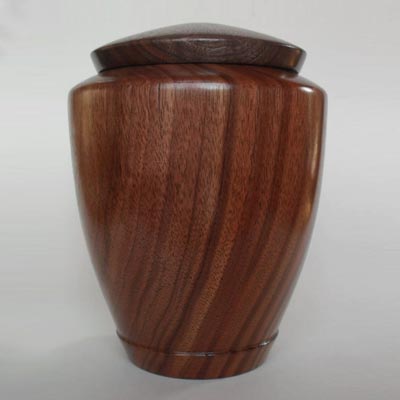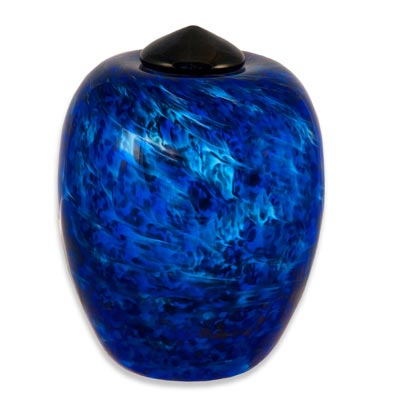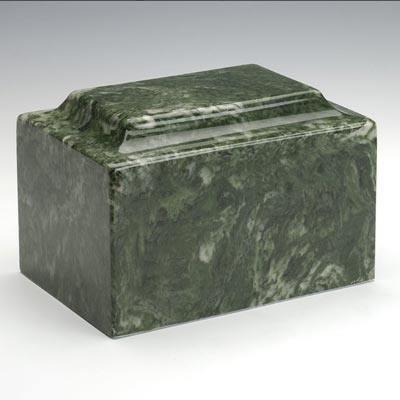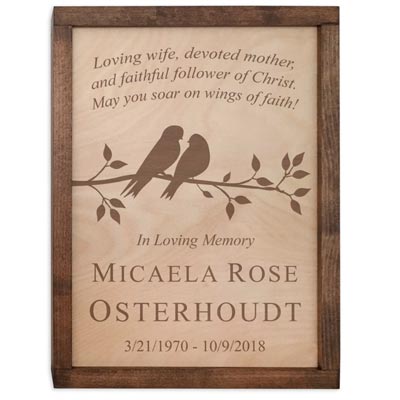Are ashes loose in an urn?
When you receive the cremated remains, they will be in a plastic bag inside of a plastic or cardboard container. What you do with the remains, or "ashes," from there is up to you.
Let's take a closer look at how to properly handle cremated remains, whether they will (or should) be loose inside the urn, and what options you have.
The information in this article applies to both human and pet ashes/remains.
How Do the Ashes Come After Cremation?
Once the cremation is complete, the cremated remains (also known as "ashes") will be put into a plastic bag which is then placed into a container called a temporary urn.
Read more:
If you provided your own urn or purchased one from the funeral home ahead of time, the funeral director or crematory operator will put the ashes into the urn for you.
Typically the remains will be in the urn inside of the plastic bag, but some urns are designed to hold and seal the remains without the use of a liner.
Are Ashes Loose In an Urn?
No. At least, the ashes are not loose in the temporary urn when you receive your loved one's remains back from the crematorium or funeral home.
As mentioned above, the remains will be in a plastic bag. That bag or liner can be removed and placed into the permanent urn. This is easy to do yourself, or you can ask the funeral director to do it for you.
Depending on the urn you choose as the final resting place for your loved one's ashes, you may want to keep the remains in the plastic bag or pour the remains directly into the urn.
Most rectangular or box-shaped urns (wood, metal, etc) will take the remains in the plastic bag. Vase-shaped urns (glass, ceramic, metal, etc) are designed to hold the remains directly in the urn, with the top lid usually sealed on.
However, many people prefer to line the vase-shaped urns with a plastic liner for additional security and peace of mind.
How Do You Put Ashes In an Urn?
You are always free to purchase the urn anywhere you like. (We hope you choose us! We offer beautiful urns and memorials at great prices with the very best customer service.)
If you buy an urn online and it arrives after the cremation is complete, you can transfer the remains yourself, ask a friend or family member to do it, or take both the temporary and permanent urn back to the funeral home so that the funeral director can do it for you.
(Talk to the funeral director or crematorium first; most are happy to help you out in this way but it is polite to tell them your plans and ask for their assistance.)
Wood Urns
For example, wooden urns are typically box-shaped and designed to open from the bottom.
You (or the funeral director) would flip the wood urn upside-down, remove the screws that attach the bottom panel, open the temporary urn, then take the plastic bag of remains and set it into the new wood urn.
Then reattach the base panel and the transfer is complete.
Turned Wood Urns
Hand-turned wood urns are a different because they are vase-shaped with a top opening lid.
You can sometimes squeeze the original plastic bag of remains into the urn; however, it's simpler to either line the urn with a new plastic bag, or just pour the remains directly into the urn.
You would then seal the top lid with silicone caulk.
Ceramic Urns
Most ceramic urns are vase-shaped with a top opening lid. You can use a plastic bag as a liner, twist tie it closed, and then leave the lid unsealed or seal it with a bead of silicone caulk.
The lid either rests on top or has a short threading on the lid; in either case, we recommend sealing the lid with silicone, and especially so if you do not use a liner.
Glass Urns
Our hand-blown glass cremation urns are true works of art. The vase-shaped urn has a top opening lid that simply rests on top of the urn.
As with ceramic urns, you can pour the remains directly into the urn or use a liner. Either way, we recommend sealing the lid with silicone.
Marble, Granite, and Stone Urns
While there are some vase-shaped ones, most stone urns are rectangular with a bottom-opening threaded stopper.
To transfer the ashes into this type of urn, you would flip it upside down and pour the remains directly into the urn. No need for a plastic liner; however, as with any urn you may use one if you prefer.
These urns are generally designed with a stopper or threaded gasket that is sufficient to close and seal the remains inside the urn.
Wall Mounted Plaque Urns
These memorials are our very own original creation. They're a series of a wall-mounted cremation urns that look like memorial plaques, which don't draw attention to themselves as urns.
The top part of the frame comes off and there is a gap between the front and back panels where the the ashes go. For these urns, we provide a plastic liner that is suited to the plaque's uniquely narrow shape.
Simply line the interior of the urn and pour the remains inside. Twist tie or fold over the bag, then replace the lid. It will be mounted onto the wall so it's not going anywhere!
Are Urns Sealed Shut?
Yes and no. It depends on the urn. For some urns, it depends on your preference.
Generally speaking, if the ashes are in a plastic bag or liner inside the urn, you do not need to seal the urn. In that case, sealing the urn is optional.
If the ashes are not in a liner but rather poured directly into the urn, most people prefer to seal the urn. If the urn is a vase-shaped memorial with a threaded lid, you may not need to seal it. The threaded lid will often have some sort of gasket, which serves to effectively seal the urn.
However, if the lid simply rests on top and you've poured the ashes directly into the urn, we recommend that you seal the urn lid with silicone or some other sealant.
Plastic Liners, Sealant, Both, or None? A Quick Guide
Top-Opening Urns
- Liner: Optional
- Seal the lid: Optional; recommended
Bottom-Opening Urns (with panel opening)
- Liner: Use original plastic bag
- Seal the panel: Not necessary
Bottom-Opening Urns (with gasket/stopper)
- Liner: Not necessary
- Seal the stopper: If it has a gasket or O-ring, sealant is not necessary
Breakable Urns (glass/ceramic)
- Liner: Optional; recommended in case the urn ever gets knocked over and breaks
- Seal the lid: Optional; recommended
---
We hope this article has answered all your questions about ashes being loose inside the urn.
If you're ready to choose the cremation urn for your loved one's final resting place, start by browsing our many collections of premium, gorgeous urns here.
But if you have further questions, continue reading through our informational articles or simply contact us by phone (877-900-5309) or email. We're happy to help; knowledgeable and capable staff are ready and empowered to help you with anything you need.
Contact us during daytime business hours or leave a message and we'll get back to you right away.






